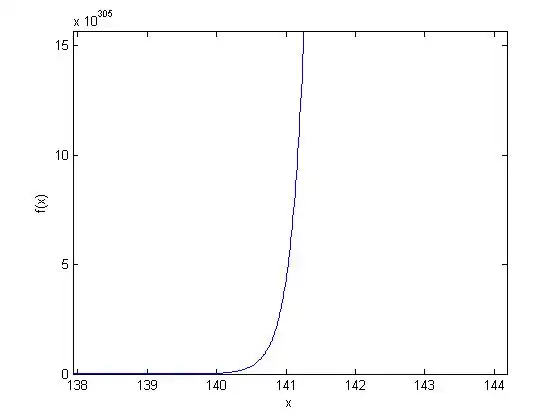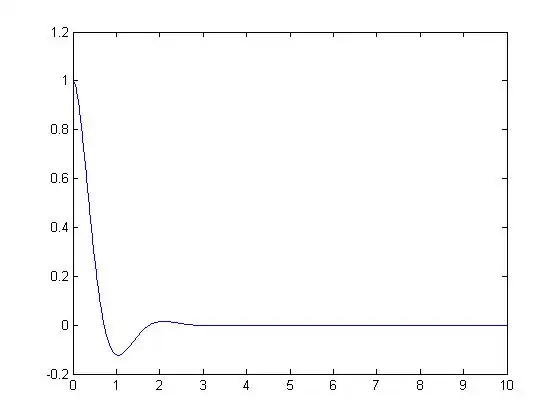University of Florida/Egm4313/s12.team15.r2
<Team 15
REPORT 2
R2.1
Given
Find
Find the non-homogeneous linear 2nd order ordinary differential equation with constant coefficients in standard form and the solution in terms of the initial conditions and the general excitation .
Then plot the solution.
Solution
Some of the following standard equations were referenced from the textbook Advanced Engineering Mechanics 10th Ed. Kreyszig 2011.
Standard Form:
Therfore,
Standard Form:
Standard Form:
Therefore,
If
then
If
then
Final Solution:
Plot of Solution:

Author
Solved and typed by Kristin Howe
Reviewed By -
R2.2
Given
Find
Solution
Author
Solved and typed by -
Reviewed By -
R2.3
Problems referenced from Advanced Engineering Mechanics 10th Ed. Kreyszig 2011 p.59 problems.3-4
Given
3a)
3b)
Find
Find the general solution of the ODEs.
Solution
3a)
Using the quadratic formula:
where are the 2 different roots generated using quadratic formula.
Plug-in and solve using known variables (b=6, a=1, c=8.96)
Therefore,
The General Solution formula for Distinct Real roots is
Now substitute the known roots into the General Solution formula:
Check using substitution. First, find the 1st and 2nd derivative of general solution formula:
Then, plug in the known variables into the original equation:
(Original Equation)
By inspection, all of the terms on the left side of the equation cancel out to 0, making the expression correct. Therefore, the general solution is correct.
3b)
Using the quadratic formula:
where are the 2 different roots generated using quadratic formula.
Plug-in and solve using known variables (b=4, a=1, c=[ + 4])
Therefore,
The General Solution formula for Complex Conjugate roots is
Now substitute the known roots into the General Solution formula:
Check using substitution. First, find the 1st and 2nd derivative of general solution formula:
Then, plug in the known variables into the original equation:
(Original Equation)
By inspection, all of the terms on the left side of the equation cancel out to 0, making the expression correct. Therefore, the general solution is correct.
Author
Solved and typed by - Tim Pham 19:36, 07 February 2012 (UTC)
Reviewed By -
R2.4
The following problems are referenced from Advanced Engineering Mechanics 10th Ed. Kreyszig 2011 p.59.
For additional information and/or practice reference Advanced Engineering Mechanics 10th Ed. Kreyszig 2011 p.53-59 and the lecture notes Lecture 5.
- Note the lecture notes and Advanced Engineering Mechanics 10th Ed. Kreyszig 2011 textbook were used to solve the following.
Given
4a)
4b)
Find
Find the general solution. Check answer by substitution.
Solution
4a)
Finding the roots:
Both solutions above show the double root characteristic so the following is applied:
This is due to double integration.
So,
Choose
General Solution
Check by substitution
Since all terms cancel out then by substitution the general solution does hold true.
4b)
Divide by 10 to simplify equation :
Solving for the roots:
This shows the double root characteristic.
So, the following is applied
This is due to double integration
So
Choose
General Solution
Check by Substitution
Since all terms cancel out then through substitution it can be confirmed that the general solution
does hold true.
Author
Solved and typed by - Cynthia Hernandez
Reviewed By -
R2.5
Given
Problem 16, P 59 Kreyszig:
Problem 17, P 59 Kreyszig:
Find
Problem 16, P 59 Kreyszig:
ODE in the form:
Problem 17, P 59 Kreyszig:
ODE in the form:
Solution
Problem 16, P 59 Kreyszig:
For two distinct real-roots:
Where:
and
The characteristic equation is:
Multiplying the roots of the equation together:
Therefore the ODE is:
Problem 17, P 59 Kreyszig:
For real double root:
Where:
The characteristic equation is:
Multiplying the roots of the equation together:
Therefore the ODE is:
Author
Solved and typed by - Neil Tidwell 1:55, 06 February 2012 (UTC)
Reviewed By -
R2.6
Given
Spring-Dashpot-Mass System from Sec 1 lecture notes.

Has double real root
Find
Solution
For spring-mass-dashpot system:
This simplifies to:
Multiply roots together to get characteristic equation:
Set coefficients of simplified spring-mass-dashpot equation equal to those of characteristic equation:
Have one degree of freedom, so arbitrarily choose
Solve system:
Author
Solved and typed by - Neil Tidwell 2:14, 06 February 2012 (UTC)
Reviewed By -
R2.7
Given
Develop the MacLaurin Series (Taylor Series at ) for
Find
Solution
Author
Solved and typed by - Jenny Schulze
Reviewed By -
R2.8
Given
Find a general solution to the equations, and check answers by substitution.
Problem 8
(8.0)
Problem 15
(8.1)
Find
Factor as in the text and solve.
Solution
Author
Solved and typed by - Jenny Schulze
Reviewed By -
R2.9
Given
Initial Conditions:
No excitation:
Find
Find and plot the solution for the L2-ODE-CC corresponding to:
In another Fig., superimpose 3 Figs.: (a) this Fig., (b) the Fig. in R2.6 p.5-6, (c) the Fig. in R2.1 p.3-7.
Solution
The corresponding ODE in standard form:
To find the roots of the ODE, convert ODE to this form:
which in this case is:
use the formula to find the roots:
because the roots are complex conjugates, the general solution can be given as:
to find A and B, we use the initial conditions and take the first derivative of y(t):
thus:
The graph of the solved equation is shown below in Fig. 1.

The three graphed equations are shown together below in Fig. 2

Equation 1 (R2.9):
Equation 2 (R2.6):
Equation 3 (R2.1):
Author
Solved and typed by - --James Moncrief 01:42, 8 February 2012 (UTC)
Reviewed By -
Contributing Members
Team Contribution Table | |||||
| Problem Number | Lecture | Assigned To | Solved By | Typed By | Proofread By |
| 2.1 | Lecture 3 | Kristin Howe | Kristin Howe | Kristin Howe | Name |
| 2.2 | Lecture 5 | Jerry Shugart | Jerry Shugart | Jerry Shugart | Name |
| 2.3 | Lecture 5 | Tim Pham | Tim Pham | Tim Pham | Name |
| 2.4 | Lecture 5 | Cynthia Hernandez | Cynthia Hernandez | Cynthia Hernandez | Name |
| 2.5 | Lecture 5 | Neil Tidwell | Neil Tidwell | Neil Tidwell | Name |
| 2.6 | Lecture 5 | Neil Tidwell | Neil Tidwell | Neil Tidwell | Name |
| 2.7 | [Lecture link] | Jenny Schulze | Jenny Schulze | Jenny Schulze | Name |
| 2.8 | [Lecture link] | Jenny Schulze | Jenny Schulze | Jenny Schulze | Name |
| 2.9 | Lecture 6 | James Moncrief | James Moncrief | James Moncrief | Name |